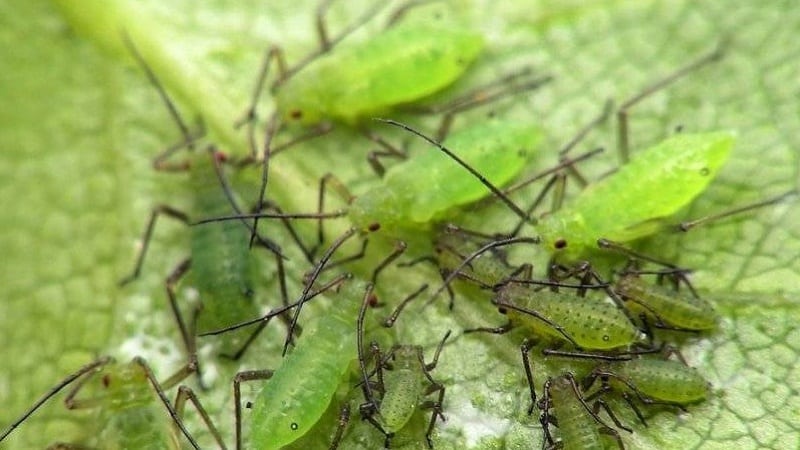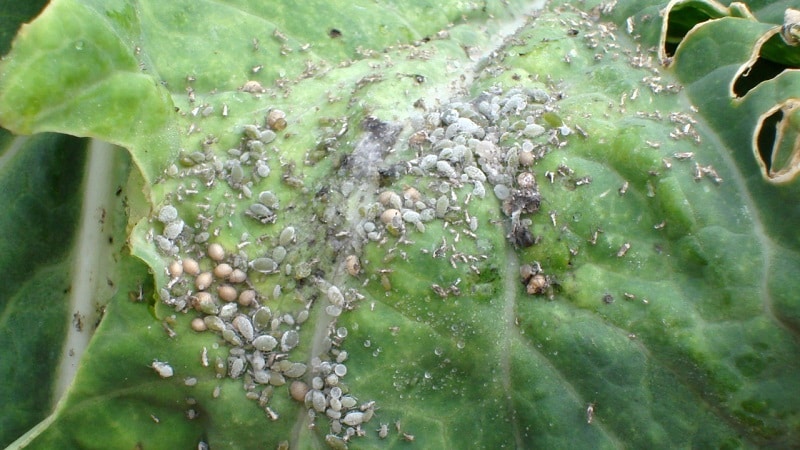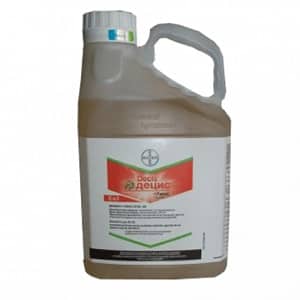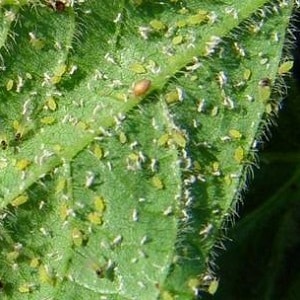How to fight aphids on cucumbers in a greenhouse: effective methods and preventive measures
Cucumbers are heat- and moisture-loving and thrive in greenhouse conditions. However, this also attracts pests. One of the most common and dangerous for vegetables is aphids.
What kind of insect this is, why it appears and how to fight it, we will tell you in the article.
Reasons for appearance
The melon or cotton aphid settles on cucumbers. This miniature insect reaches a length of 3-4 mm. The body of an adult is colored in various shades of green, the legs and antennae are black or dark brown. Not everyone has wings. The larvae are smaller and lighter in color. The development of one generation from the larva to the mature form lasts from 9 to 12 days.
Flight of overwintered females begins at an air temperature of +12 ºC. In greenhouses and greenhouses, already at the beginning of May there is a risk of plantings being damaged by aphids.

The main reason for the appearance of insects in the greenhouse - ants that carry them to plants and protect them from predators. Increased temperature and humidity contribute to the prosperity and active reproduction of the pest.
Damage caused
Aphids feed on plant cell sap. Damaged leaf plates wrinkle and dry out. In the tissues of vegetables, the formation of nutrients necessary for growth and the formation of ovaries is disrupted. Uncontrolled reproduction of the pest leads to the death of the vegetable and complete loss of the harvest.
Another aspect of the harmfulness of aphids - spread of cucumber mosaic virus.
Signs of defeat
Cucumber bushes infected with aphids look like this:
- leaves are faded, twisted, drooping;
- flowers and ovaries fall off;
- small insects are visible on the back of the leaf;
- The leaf blades on the back are covered with a thin film of sticky aphid secretions.

As the colony grows in size insects inhabit stems, buds, and young shoots.
How to deal with aphids on cucumbers in a greenhouse and greenhouse
It is not difficult to remove aphids from a greenhouse or greenhouse. The pest is susceptible to a wide range of drugs.
To succeed in fighting insects, follow two rules:
- At the same time as destroying the pest, eliminate the ants.
- Apply any treatment to the underside of the sheet.
Read about other pests:
Why black aphids are dangerous on cucumbers and how to fight them
Chemicals
Pesticides are used when more than 10% of plants are infested with aphids. Drugs have a powerful effect against pests:
- "Fitoverm" — 5% aqueous emulsion of aversectin C. It has a nerve-paralytic effect, due to which pests die 1–3 days after treatment. Does not cause resistance, safe for humans. The working liquid is prepared by dissolving 2 ml of the product in 1 liter of water. Spraying is carried out 2-3 times during the growing season with an interval of 14–20 days. The harvest can be harvested 3 days after treatment.
 "Decis Lux" — emulsion of contact-intestinal poison based on deltamethrin. The product is packaged in ampoules or bottles of various sizes. To treat cucumbers, 5 ml of the drug is dissolved in 20 liters of water. Spraying is carried out when the first individuals appear, and if they appear again - after 2 weeks. The waiting period before harvesting is 20 days.
"Decis Lux" — emulsion of contact-intestinal poison based on deltamethrin. The product is packaged in ampoules or bottles of various sizes. To treat cucumbers, 5 ml of the drug is dissolved in 20 liters of water. Spraying is carried out when the first individuals appear, and if they appear again - after 2 weeks. The waiting period before harvesting is 20 days.- "Inta-Vir" - a chemical of contact-intestinal action, the main substance of which is cypermethrin. It is produced in the form of tablets weighing 8 g. To combat aphids, dilute 1 tablet per 10 liters of water. Processed during the growing season at least 20 days before harvesting cucumbers.
- "Metaphos" - a contact action agent, the active substance is parathion-methyl. Available in the form of an emulsion in ampoules of 5 ml. To prepare the working solution, the contents of 2 ampoules (10 ml) are diluted in 10 liters of water. Treatment is carried out in the early morning or evening. The last spraying is no earlier than 30 days before harvesting the fruits.
Important! Insects develop resistance to chemicals. Use the products only in the doses indicated in the instructions and alternate the drugs throughout the season.
Folk recipes
Folk remedies are less effective than chemicals. However, they are safer for humans and plants. The use of infusions and decoctions against aphids is justified when no more than 10% of the bushes are affected.
Here are some popular recipes:
- Infusion of shag or tobacco. Pour 300 g of dry shag (tobacco) into 10 liters of water and leave for 2 days. Before use, strain and add 70 g of grated laundry soap.
- Vinegar solution. 1 tbsp. Dissolve a spoonful of 9% vinegar in a bucket of water.
- Hot pepper tincture. Grind 50 g of red hot pepper pods, pour in a liter of boiling water and leave for 2 hours. Strain the product and dilute with 10 liters of water.
- Infusion of celandine. 200–300 g of dry herb is poured into a bucket of water, left for a day, and filtered before use.
- Garlic tincture. Chop 500 g of garlic, add 3 liters of water, leave in a dark place for 5 days. To prepare the working solution, take 50 ml of infusion per 10 liters of water.
- A mixture of ash and laundry soap.50 g of wood ash and 70 g of grated laundry soap are mixed with 10 liters of water.
Cucumbers are processed in one of the following ways until the pest completely disappears every week. Spraying consumption - 1 l per 10 m2.
Agrotechnical methods
Proper agricultural technology is aimed at maintaining plant health. Weakened or “overfed” vegetables are more likely to be attacked by pests and recover more slowly from damage.
A number of techniques will help you cope with aphids and prevent them from appearing in the future.:
- Replace the top layer (10–12 cm) of soil every 1-2 years, since maintaining crop rotation in greenhouses and hotbeds is difficult.
- Destruction of weeds, cleaning the beds of all plant debris.
- Timely and correct watering. Young bushes require moderate watering: 5 liters of water per 1 m2 about once a week, during flowering - an average of 8 liters per 1 m2 every 2-3 days, during the fruiting period - about 10 liters per 1 m2 in one day.
- Regular fertilizing according to plant needs. It is enough to feed greenhouse cucumbers 4 times per season: 2 weeks after planting the seedlings, during flowering, at the beginning of the mass formation of ovaries and about 10 days after the third feeding.
And a little about diseases:
Preventive measures
There are a number of recommendations to prevent the appearance of aphids:
 The most important thing is to fight ants with all available means. Among insecticides, it is recommended to use “Aardvark”, “Thunder”, “Absolute”. Boric acid powder is effective. Irreparable damage is caused to anthills by spilling boiling water on them.
The most important thing is to fight ants with all available means. Among insecticides, it is recommended to use “Aardvark”, “Thunder”, “Absolute”. Boric acid powder is effective. Irreparable damage is caused to anthills by spilling boiling water on them.- Carefully remove all plant debris from the greenhouse: eggs and larvae of the pest remain on the weeds and tops.
- Do not plant more than 4 cucumber bushes per 1 m2: Aphids spread faster in dense plantings.
- Inspect the plants weekly: the sooner you detect pests, the more successful the fight will be.
- Plant plants that repel aphids in the rows: garlic, marigolds, basil, peppermint, cilantro.
- For open plantings: attract aphid-eating birds to the area. To attract sparrows, tits, and linnets, hang feeders around your garden plot.
We should also talk about the disinfection of greenhouses and greenhouses.
Greenhouse disinfection
Disinfection of greenhouses significantly reduces the risk of next pest and disease season. Disinfection work is carried out every year after harvesting and cleaning the premises. The air temperature should not be lower than +8…+10 ºС. Disinfection can be gas or wet.
Gas is used in sealed rooms: fumigated with sulfur at the rate of 50 g per 1 m3 premises. Trays with sulfur bombs are placed in different places and set on fire. The doors are closed tightly and left for 3 days. Then the greenhouse is well ventilated.
Wet disinfection is more accessible - copious spraying of all surfaces and structures with antiseptics. For processing use:
- bleach solution - 400 g of the substance is infused for at least 3 hours in 10 liters of water;
- formaldehyde solution - 250 g dissolved in 10 liters of water.

Reviews
Every experienced gardener has his own proven method. aphid control:
Lyudmila, Samara: “As a matter of principle, I try not to use chemicals at my dacha. My proven method against aphids is potato tops. I fill a kilogram of tops with a bucket of water and let it brew for 3–5 hours. I filter, add a little liquid soap and spray the cucumbers.It is important not to overdo the concentration: the tops are highly poisonous and can cause burns on the leaves.".
Julia, Moscow region: “I have been using the drug Fitoverm for several years. I dilute it strictly according to the instructions. After a few days, there are no living adult aphids left, but eggs remain. Therefore, after about a week or 10 days I repeat the treatment. To consolidate the effect, I spray it again after a couple of weeks. This is enough for a season.".
Conclusion
Aphids are small insects that feed on the juices of cucumbers. The pest destroys plants and crops: the foliage withers, turns yellow, dries out, flowers and ovaries crumble.
For minor infections, folk remedies are effective. If more than 10% of the bushes are affected, insecticides are used. Proper agricultural practices help fight the pest: maintaining cleanliness in the beds, sufficient and timely watering and fertilizing.
Weekly inspections of plants will allow you to detect insects earlier, begin to fight them in a timely manner and save the harvest.
The main carrier of aphids is ants, so the main preventative measure is to control the number of ants. Post-harvest disinfection of greenhouses will help prevent pests from appearing next season.